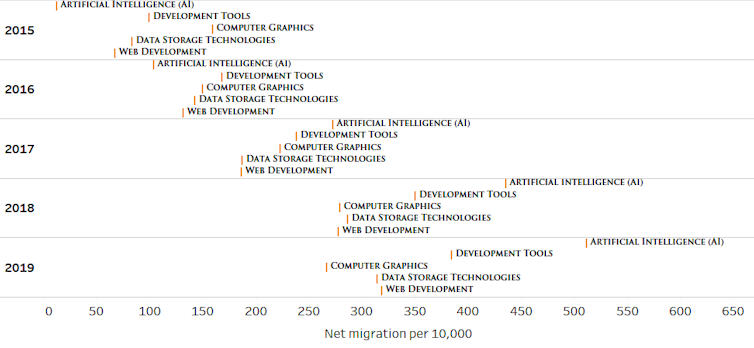The major world economies of today are innovation-driven knowledge centres. To move innovation forward, an economy cannot operate from a limited pool of local knowledge and skills. It must be able to access the larger pool of global talent.
Foreign knowledge and skills bring new ideas, new perspectives and links to new markets that benefit Canadian employers enormously. A recent study by Statistics Canada shows that immigrant workers contribute significantly to business productivity over the long term. This impact is even stronger among firms in technology-intensive and knowledge-based industries.
Multinational corporations play a major role in the world economy by connecting knowledge resources through the placement of skilled people at branches around the world. Intra-company movement of skilled workers improves the overall productivity of the firm but also allows for countries to participate in the exchange of knowledge and ideas.
On a similar note, international students in Canada alone contribute to $21.6 billion in tuition, accommodation and other expenses, and also contribute in non-monetary terms by connecting Canada to the world economy through cultural exchange. International students and study-abroad programs introduce new perspectives into the classroom and create future global citizens.
Leadership required
Sustaining knowledge exchange requires stability and leadership. COVID-19 makes stability very difficult to achieve at the moment, but the right leadership can keep the innovation economy on a steady growth path.
In 2017, the federal government launched the Global Skills Strategy to expedite work permit applications by highly skilled foreign workers within a two-week processing window. In addition, foreign researchers and highly skilled workers on short-term work assignments don’t require a work permit.
Today, this two-week window has remained mostly closed during the pandemic to non-essential and non-support workers, leaving many employers at a competitive disadvantage in terms of attracting talent.
Similarly, international students who come to Canada to earn a Canadian credential and work experience are well-placed to obtain permanent residency. About 27 per cent of international students will become permanent residents. However, things can change quickly.
Many Indian international students initially bound for the United States and Canada have enrolled in universities in Europe instead, predominantly due to early entry restrictions in the U.S., Canada and Australia. Canadian universities are largely hosting classes online for first-year courses. For some international students, this doesn’t justify the tuition fees — about five times higher than what domestic students pay.
This will severely disrupt the momentum that has been built over the last few years in building Canada’s innovation economy.
Artificial intelligence
Cloud computing, the internet of things, 3D printing and artificial intelligence (AI) are major areas of modern-day technological advances, all of them part of what’s called the Fourth Industrial Revolution.
Each of these technologies are developing rapidly and being used in a wide array of industries. But AI is expected to have the biggest impact on the labour market.
AI discussions are focused predominantly on its potential to displace workers. But AI can also work alongside existing employees to make them more productive without decreasing the total number of jobs available. That is, AI complements high-skilled workers.
The Fourth Industrial Revolution demands a large technical skill base. Local labour markets are in short supply of highly skilled workers given the current pace of growth in the technology industry. For this reason, highly skilled migration is an important source of sustained growth in Canada’s innovation economy.
Using data from LinkedIn and the World Bank, I can see the types of skills that employers have imported from abroad. LinkedIn’s membership mostly consists of white-collar workers in knowledge-intensive sectors. The figures below are not meant to represent the entire migration landscape of Canada, but only how foreign workers contribute their skills to the tech sector.
In 2015, less than one per cent of foreign workers contributed skills in artificial intelligence. By 2019, this figure increased to five per cent. Similarly, there’s been increasing demand for foreign workers with specialized skills in development tools, computer graphics, data storage technologies and web development over the past five years leading up to the COVID-19 pandemic:

Tech sector shows some resilience
A report by Brookfield Institute in 2015 finds that Canada’s tech sector represented $117 billion in economic output.
The sector has been consistently larger than the finance and insurance industry since 2007, and even outpaced annual growth of the mining, quarrying and oil and gas extraction sectors. The tech sector is the largest contributor to research and development, product innovation and organizational innovation, and is the second-largest contributor to process innovations in Canada.
The tech sector has shown some resilience dealing with the economic effects of the pandemic. Many existing tech workers in Canada were able to make the move to remote work more easily than those employed in other sectors. While employment levels decreased by 15 per cent between February and April 2020, tech employment decreased by only 4.2 per cent. But this doesn’t remove the need for new foreign workers in the tech industry to build on the momentum created over the last few years.
Canada recently showed leadership in reopening its borders to international students while ensuring that post-secondary institutions do their part to keep students and the community safe.
The Canadian government understands that students’ and community safety are of prime importance, but also that students want to complete their studies in a timely manner.
The federal government should extend this leadership to foreign workers. To ensure that foreign workers continue to view Canada as a place to live, work and contribute to the innovation economy, the government must keep Canada’s borders open not just to foreign workers in essential services but to all workers essential to the post-pandemic economic recovery.![]()
Stein Monteiro, Research Fellow, CERC Migration Program, Ryerson University
This article is republished from The Conversation under a Creative Commons license. Read the original article.
